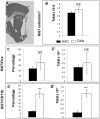Human neural progenitor cell engraftment increases neurogenesis and microglial recruitment in the brain of rats with stroke
- PMID: 23185625
- PMCID: PMC3503964
- DOI: 10.1371/journal.pone.0050444
Human neural progenitor cell engraftment increases neurogenesis and microglial recruitment in the brain of rats with stroke
Abstract
Main objectives: Stem cell transplantation is to date one of the most promising therapies for chronic ischemic stroke. The human conditionally immortalised neural stem cell line, CTX0E03, has demonstrable efficacy in a rodent model of stroke and is currently in clinical trials. Nonetheless, the mechanisms by which it promotes brain repair are not fully characterised. This study investigated the cellular events occurring after CTX0E03 transplantation in the brains of rats that underwent ischemic stroke.
Methods: We focused on the endogenous proliferative activity of the host brain in response to cell transplantation and determined the identity of the proliferating cells using markers for young neurons (doublecortin, Dcx) and microglia (CD11b). So as to determine the chronology of events occurring post-transplantation, we analysed the engrafted brains one week and four weeks post-transplantation.
Results: We observed a significantly greater endogenous proliferation in the striatum of ischemic brains receiving a CTX0E03 graft compared to vehicle-treated ischemic brains. A significant proportion of these proliferative cells were found to be Dcx+ striatal neuroblasts. Further, we describe an enhanced immune response after CTX0E03 engraftment, as shown by a significant increase of proliferating CD11b+ microglial cells.
Conclusions: Our study demonstrates that few Dcx+ neuroblasts are proliferative in normal conditions, and that this population of proliferative neuroblasts is increased in response to stroke. We further show that CTX0E03 transplantation after stroke leads to the maintenance of this proliferative activity. Interestingly, the preservation of neuronal proliferative activity upon CTX0E03 transplantation is preceded and accompanied by a high rate of proliferating microglia. Our study suggests that microglia might mediate in part the effect of CTX0E03 transplantation on neuronal proliferation in ischemic stroke conditions.
Conflict of interest statement
Figures






References
-
- Lloyd-Jones D, Adams RJ, Brown TM, Carnethon M, Dai S, et al. (2010) Heart disease and stroke statistics–2010 update: a report from the American Heart Association. Circulation 121: e46–e215. - PubMed
-
- Adams HP Jr, del Zoppo G, Alberts MJ, Bhatt DL, Brass L, et al. (2007) Guidelines for the early management of adults with ischemic stroke: a guideline from the American Heart Association/American Stroke Association Stroke Council, Clinical Cardiology Council, Cardiovascular Radiology and Intervention Council, and the Atherosclerotic Peripheral Vascular Disease and Quality of Care Outcomes in Research Interdisciplinary Working Groups: The American Academy of Neurology affirms the value of this guideline as an educational tool for neurologists. Circulation 115: e478–534. - PubMed
-
- Pollock K, Stroemer P, Patel S, Stevanato L, Hope A, et al. (2006) A conditionally immortal clonal stem cell line from human cortical neuroepithelium for the treatment of ischemic stroke. Exp Neurol 199: 143–155. - PubMed
-
- Stroemer P, Patel S, Hope A, Oliveira C, Pollock K, et al. (2009) The neural stem cell line CTX0E03 promotes behavioral recovery and endogenous neurogenesis after experimental stroke in a dose-dependent fashion. Neurorehabil Neural Repair 23: 895–909. - PubMed
Publication types
MeSH terms
Substances
LinkOut - more resources
Full Text Sources
Other Literature Sources
Medical
Research Materials

